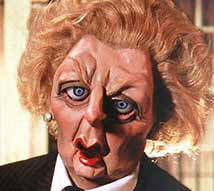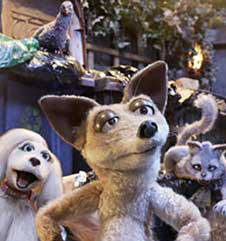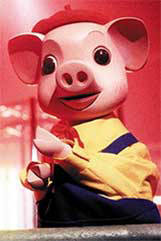
History
Others
Puppets

At 10pm on a Sunday night in 1984, Peter Fluck and Roger Law's caricatures of the famous were unveiled to British audiences. A truly adult puppet programme, Spitting Image was frequently crass and tasteless, but just as often hilarious. The caricatures of Spitting Image were to offend, outrage and amuse. Its format, of a satirical comedy sketch show with puppets rather than live actors, was inventive and at times surreal. The puppets themselves were built out of latex and were often the show's strongest attribute. Some of Spitting Image's sketches were shot and edited only hours before the show went on the airwaves, thus ensuring a fresh up-to-date topicality. The brash, uncompromising scripts kept the viewers' attention, although it could sometimes be awkward viewing.
Spitting Image prayed on well-known faces, from the Royals to MPs. In the early days, the Independent Television Authority censors demanded cuts. One scene they disliked was that of a puppet Harold Wilson MP tipping hot soup onto himself. The Conservatives were shocked at the constant micky-taking of the Royals, complaining that 'they can't answer back.' One politician was quoted to say that Spitting Image would 'denigrate what we hold most dear.' Royalists could not believe that the Queen Mother was shown as a common, stupid, horse racing fan, complete with Brumme accent. No one complained, however, when Colonel Gaddafi was blown up as he accepted the award for the International Terrorist of the Year.
On its first night, Spitting Image received an audience rating of 7.9 million, but the numbers dropped rapidly. Only three weeks after its premiere, the show was facing the axe. Spitting Image cost almost twice as much as a prime time sitcom - around £2.6 million for the first 12 episodes - so economies were desperately needed if it was to survive. The comedy in the early scripts was uneven, and Fluck and Law's inexperience with puppetry shone through. However, by the next season, with better script writing, improved puppet performances and a more efficient production, the problems were ironed out and the protesters became less vocal, if not altogether silent. The audiences grew, topping 12.6 million in January 1986. Spitting Image continued on our screens for twelve years, before being laid to rest in 1996, making it the most successful adult orientated puppet television programme ever.
Viewers tuned into Spitting Image to laugh at the abuse and parody of the rich and powerful, and the humour was greatly aided by the use of puppetry. The latex creations could be used to provide some very surreal images. The image of MP Kenneth Baker as a slug is burned into many a viewers' memory. Caricatures in the Spitting Image mould could not have been produced as effectively by any other method. Animation could have shown the ugly caricatures, but would not have captured the exaggerated human qualities that the puppets portrayed. At Spitting Image's height of popularity, the mention of Labour politician, Roy Hattersley, produced a vision of Spitting Image's salivating caricature, not the real human being. Sometimes the show's victims claimed they did not mind their puppet likenesses. Snooker player Stephen Hendry even quipped that his spotty puppet was handsome. Tory MP Michael Heseltine was one who attempted to purchase his puppet. After agreeing to pay £7500 for the privilege, he stormed out when he was asked to make the cheque payable to 'The Labour Party', thus proving that the abuse was not just confined to the television screen.
Spitting Image, in a similar fashion to The Storyteller, held many characteristics of pre-television puppetry. Theatre historian George Speaight commented that Spitting Image was a 'piece of adult satire that might have been played in a Berlin cabaret in the twenties.' Looking even further back, Punch and Judy in its heyday had a lot in common with Spitting Image, with religious or political figures turning up to be ridiculed in a satirical format. Today Punch and Judy itself has become children's entertainment. A once adult satirical show dropping to the level of slapstick children's viewing.
Satirical television puppetry was not new, however, as some kid's shows have portrayed a surprising political air. The 1960s puppet show, Pinky and Perky, originally intended purely for infants but quickly given a more family slot, received as much fan mail as The Beatles. The BBC banned one episode of Pinky and Perky in 1966 for being overtly political. The episode, titled You Too Could Be Prime Minister, was eventually aired and obtained more viewers than Harold Wilson's party political broadcast shown on ITV at the same time. Puppets and satire appear to go hand in hand.
Adult puppets programmes have not simply been confined to satire though. Sitcoms have been around since the early days of television, and in 2010 the viewers of BBC3 were introduced to a twist on the old formula. Mongrels was a sitcom with a difference - all the characters were puppet animals. There was Nelson, a metrosexual urban fox who has an unrequited love for Destiny the Afghan Hound, along with Marion the borderline-retarded cat and a grudge-bearing pigeon called Kahi. Finally there was Vince, the sociopathic foul-mouthed brother to Nelson. Vince's lines were peppered with swear words, bleeped over in the usual television manner. Aimed squarely at adult viewers, Mongrels included themes such as neutering and catnip overdoses. Some of the humour was very near the bone. In one episode, children's favourite puppet fox Basil Brush made an appearance as a Holocaust denier. I'm sure the creators of Basil would have been horrified. There were often celebrity appearances, and there was always a musical number.
The puppets themselves were realised with great skill, and were designed along the lines Jim Henson had laid down decades before with the muppets. Interestingly as a tribute, the pitch tape used when commissioning Mongrels was based on the same pitch used by The Muppet Show in the seventies. Adam Miller, the show's creator, explained that he 'wanted to make something that had the pace of an American animation but with British sensibilities, that was adult, but not crude, that was based in the realities of the animal world, and that didn't rely on the puppets to do the comedy.' It is debatable if he achieved his goal. Sam Wollaston of The Guardian newspaper said that the main reason he thought it was funny was because it depicted 'cuddly children's toys saying things you wouldn't normally expect cuddly children's toys to say.'
Although Mongrels was not the first puppet-based sitcom (that record goes to Channel 4's little known series Pets in 2001), it was brave attempt to bring puppetry to a prime-time adult audience.
From Satire to Sitcom
Puppet Sitcom Mongrols (Left)
Spitting Image's Maggie Thatcher (Above)
Perky From Pinky & Perky (Right)





This website is the copyright of Benjamin Burford-Jones 2014, except quotations and photographs used to illustrate various traditional and television puppets.
No material should be reproduced in any form whatsoever for purposes of commercial gain without obtaining the copyright holder’s express permission.
Herb the Owl | Alex the Droog | What is a Puppet | Watching With Mother | Gerry Anderson | Jim Hensons Muppets
From Satire to Sitcom | Are Puppets Just for Kids | About the Author and Links















